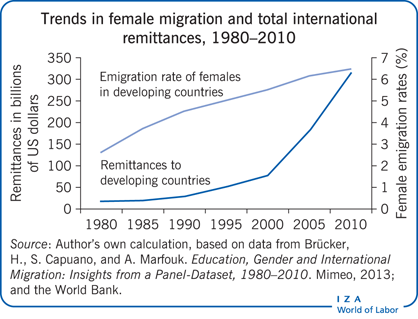Elevator pitch
Migrants’ remittances to developing countries have increased in recent decades, partly due to reduced transactions costs and improved living conditions in host countries. The feminization of international migration represents yet another explanation. Despite the difficulties female migrants encounter in the labor market, their total remittances may be higher and more resilient than those of male migrants, owing to these women’s stronger links to family members left behind and self-insurance motives. Policymakers need to understand how this new and significant upward trend in female migration could affect the economic and social development of home countries.

Key findings
Pros
Women are increasingly moving independently in search of better jobs, leaving family members behind and generating remittances.
Female migrants tend to stay linked to and sacrifice more for the family back home, thus adding to the reliability of their remittances.
Female migrants face uncertainty and risk in destination labor markets; this may encourage them to remit to self-insure against possible negative shocks.
The rising emigration rate of skilled women may have a positive impact on remittances due to higher earnings.
Cons
The “double disadvantage” of being an immigrant and female could negatively affect job quality and earnings in the host country.
Many female migrants are employed in domestic jobs and hold temporary work contracts; the low wages they earn abroad and their limited access to property rights back home means their future return plans are associated with fewer remittances.
Many women continue to migrate to join their families, especially in developed countries, leaving behind fewer close relatives.
Women’s professional outcomes tend to be negatively affected when they migrate with their husbands.